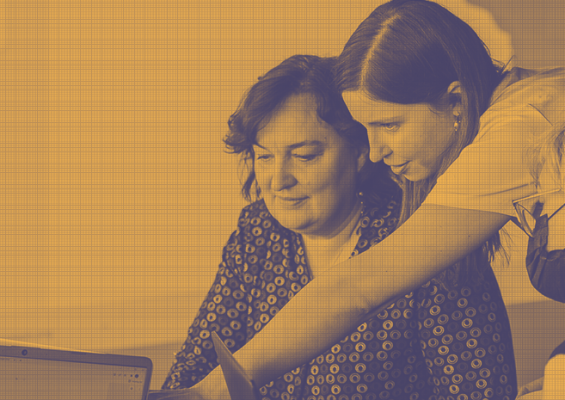According to the World Economic Forum, 65 percent children starting school today will be working with technologies in the future that do not yet exist.
“That is why it is especially important to promote and properly develop information technology, mathematical and logical thinking, knowledge and competences in educational institutions from the elementary grades, because this is the most direct way to the growth, development and success of business as well as the entire city,” Laura Baltkojytė, manager of the investment environment projects of the business department of Kaunas IN, comments on the importance of education in the long-term perspective of the city’s development.
Thousands of elementary school pupils studying computer science in Kaunas
Loreta Prochorskienė, a primary school teacher at the Simonas Daukantas Progymnasium in Kaunas says that it were the children themselves, who became the impetus for her to start teaching informatics to primary school pupils, “Today’s children start using digital technologies before pencils, they are very interested in them. I realized that I need to keep up with them. In order to be able to involve the children in learning in a different way, I have to improve myself.”
The computer science and technological creativity learning program Vedliai helps her to prepare for such lessons. As of now, 261 elementary school teachers from Kaunas and 107 teachers from Kaunas district have joined the program. They teach basic informatics and technology skills to more than 6 thousand elementary school students in Kaunas and the Kaunas district.
Jekaterina Juknevičienė, the headmistress of Simonas Daukantas Progymnasium in Kaunas, points out the need for all schoolteachers to learn computer science and apply it in lessons. Back in 2015, when she became the head of Simonas Daukantas Progymnasium, strategic directions were clarified with the school community. One of them is the direction of science education, focus on STEAM subjects.
“We have prepared an IT implementation strategy, the success of which is evidenced by simple numbers. We started with only 2 computers in primary education classrooms and today all the teachers’ workplaces are computerized, equipped not only with multimedia projectors (29) but also with smart screens (19, including 6 in primary classrooms), and interactive whiteboards. We have 5 hybrid classes, one of which is for elementary school pupils. So, it is not surprising that teacher L. Prochorskienė’s proactive leadership after independently joining the Vedliai program, her enthusiasm when talking about the training, the materials, the help provided, and about how interesting all this is for children, encouraged other colleagues to join as well. This year, the school provided an opportunity to all teachers, who want to participate in the program,” the headmistress talked about school’s consistent steps in integrating informatics into the educational process and methods.
The answer to the question “Will I be able to?”
“The main goal of Vedliai is to involve teachers to ensure that every child grows up with basic informatics and technology skills, thus preparing them for a life in which informatics is like the new English, without which competitiveness and successful integration are impossible,” says Viltautė Žvirzdinaitė, head of Vedliai program in Lithuania.
During the continuous Vedliai program, pedagogues learn in virtual practical sessions, where, with the help of mentors, they get to know various technologies and learn to create with them. The participants in the program are also provided with classroom-ready content: a digital textbook and digital exercises, where computer science is connected to classroom topics through creative, mathematical and logical practices that stimulate thinking.
One of the biggest challenges for educators themselves is the question “Will I be able to do it?” However, as V. Žvirzdinaitė emphasizes, the learning platform is flexibly adapted to the teacher’s own level and knowledge. Beginners are gradually introduced to informatics from scratch, while advanced users are presented with various ways on how to use technological creation with children.
As L. Prochorskienė, who has been training in the program for several years, says, the biggest challenge for her was to start programming with the students for the first time, “I was afraid, that I wouldn’t be able to explain it to them. Perhaps that first step was the most difficult, the question kept arising: what if I fail?! But it turned out that children absorb everything much faster, they just need to be put on the right track and creativity starts flowing. Everything is redeemed by children’s excited screams and their activeness. Equally important is the fact that the mentors at Vedliai program are very patient and consistent in explaining and encouraging. If necessary, they repeat as many times as necessary, until everything finally works. Thanks to the program, I started looking at informatics in a completely different way, and I can integrate it into different subjects that I teach.”
Mathematical skills and creativity are improving
As the organizers of the program note, integrating informatics into primary education not only visibly increases children’s digital literacy, but also, as evidenced by the teachers’ own feedback, improves mathematical abilities, creativity, increases children’s motivation, concentration and the joy of learning.
“New activities make children happy. Students perceive the tasks they need to complete on the computer as a game because they are used to computer games. Various tasks help to include children with special needs and also motivate gifted students. Students are not just consumers, they become discoverers, creators, innovators, which gives them self-confidence and encourages them to be interested, gain new knowledge, maybe even create something new and unusual. For example, in 3rd grade math class we were learning about perimeter, so the students created a game in Scratch where Labinas the cat asks for help calculating perimeters using addition, subtraction, and multiplication. You can see what we came up with here. Or while learning about historical periods, we created educational material, a cartoon Traveling in Time Machine, which helps consolidate knowledge about the characteristics of historical periods,” the teacher rejoices, presenting the biggest and most serious works of her primary school students.



